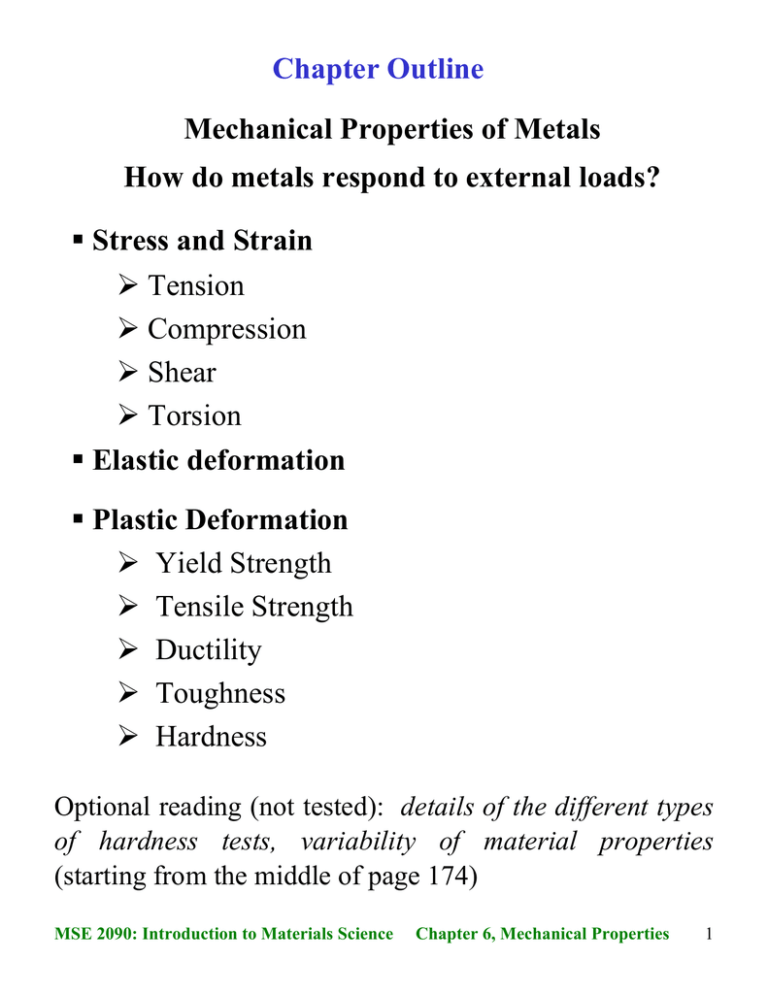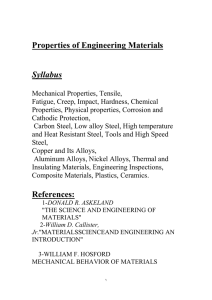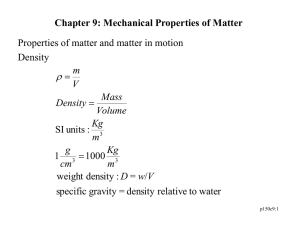Mechanical Properties of Metals How do metals respond to external
advertisement

Chapter Outline Mechanical Properties of Metals How do metals respond to external loads? Stress and Strain ¾ Tension ¾ Compression ¾ Shear ¾ Torsion Elastic deformation Plastic Deformation ¾ Yield Strength ¾ Tensile Strength ¾ Ductility ¾ Toughness ¾ Hardness Optional reading (not tested): details of the different types of hardness tests, variability of material properties (starting from the middle of page 174) MSE 2090: Introduction to Materials Science Chapter 6, Mechanical Properties 1 Introduction Stress, σ (MPa) To understand and describe how materials deform (elongate, compress, twist) or break as a function of applied load, time, temperature, and other conditions we need first to discuss standard test methods and standard language for mechanical properties of materials. Strain, ε (mm / mm) MSE 2090: Introduction to Materials Science Chapter 6, Mechanical Properties 2 Types of Loading Tensile Compressive Shear Torsion MSE 2090: Introduction to Materials Science Chapter 6, Mechanical Properties 3 Concepts of Stress and Strain (tension and compression) To compare specimens of different sizes, the load is calculated per unit area. Engineering stress: σ = F / Ao F is load applied perpendicular to speciment crosssection; A0 is cross-sectional area (perpendicular to the force) before application of the load. Engineering strain: ε = Δl / lo (× 100 %) Δl is change in length, lo is the original length. These definitions of stress and strain allow one to compare test results for specimens of different crosssectional area A0 and of different length l0. Stress and strain are positive for tensile loads, negative for compressive loads MSE 2090: Introduction to Materials Science Chapter 6, Mechanical Properties 4 Concepts of Stress and Strain (shear and torsion) Shear stress: τ = F / Ao F is load applied parallel to the upper and lower faces each of which has an area A0. γ = tgθ (× 100 %) Shear strain: θ is strain angle Torsion is variation of pure shear. The shear stress in this case is a function of applied torque T, shear strain is related to the angle of twist, φ. Shear Torsion Ao F θ MSE 2090: Introduction to Materials Science Chapter 6, Mechanical Properties 5 Stress-Strain Behavior Elastic Plastic Elastic deformation Reversible: when the stress is removed, the material returns to the dimensions it had before the loading. Stress Usually strains are small (except for the case of some plastics, e.g. rubber). Plastic deformation Irreversible: when the stress is removed, the material does not return to its original dimensions. Strain MSE 2090: Introduction to Materials Science Chapter 6, Mechanical Properties 6 Stress-Strain Behavior: Elastic Deformation In tensile tests, if the deformation is elastic, the stressstrain relationship is called Hooke's law: σ = Eε E is Young's modulus or modulus of elasticity, has the same units as σ, N/m2 or Pa Stress Unload Slope = modulus of elasticity E Load Strain Higher E → higher “stiffness” MSE 2090: Introduction to Materials Science Chapter 6, Mechanical Properties 7 Elastic Deformation: Nonlinear Elastic Behavior In some materials (many polymers, concrete...), elastic deformation is not linear, but it is still reversible. Δσ/Δε = tangent modulus at σ2 Definitions of E Δσ/Δε = secant modulus between origin and σ1 MSE 2090: Introduction to Materials Science Chapter 6, Mechanical Properties 8 Chapter 2: force-separation curve for interacting atoms Energy, eV, Force, eV/Å Elastic Deformation: Atomic scale picture 0.005 Force 0 Energy -0.005 -0.01 2 4 6 8 Distance between atoms, rij, Å E ~ (dF/dr) at ro (r0 – equilibrium separation) MSE 2090: Introduction to Materials Science Chapter 6, Mechanical Properties 9 Elastic Deformation: Anelasticity (time dependence of elastic deformation) • So far we have assumed that elastic deformation is time independent (i.e. applied stress produces instantaneous elastic strain) • However, in reality elastic deformation takes time (finite rate of atomic/molecular deformation processes) - continues after initial loading, and after load release. This time dependent elastic behavior is known as anelasticity. • The effect is normally small for metals but can be significant for polymers (“visco-elastic behavior”). MSE 2090: Introduction to Materials Science Chapter 6, Mechanical Properties 10 Elastic Deformation: Poisson’s ratio Unloaded Loaded εy εx ν=− =− εz εz Materials subject to tension shrink laterally. Those subject to compression, bulge. The ratio of lateral and axial strains is called the Poisson's ratio υ. Sign in the above equations shows that lateral strain is in opposite sense to longitudinal strain υ is dimensionless Theoretical value for isotropic material: 0.25 Maximum value: 0.50, Typical value: 0.24 - 0.30 MSE 2090: Introduction to Materials Science Chapter 6, Mechanical Properties 11 Elastic Deformation: Shear Modulus Δy Zo Unloaded Loaded τ Relationship of shear stress to shear strain: τ = G γ, where: γ = tgθ = Δy / zo G is Shear Modulus (Units: N/m2 or Pa) For isotropic material: E = 2G(1+υ) → G ~ 0.4E (Note: single crystals are usually elastically anisotropic: the elastic behavior varies with crystallographic direction, see Chapter 3) MSE 2090: Introduction to Materials Science Chapter 6, Mechanical Properties 12 engineering stress Stress-Strain Behavior: Plastic deformation engineering strain Plastic deformation: ¾ stress and strain are not proportional to each other ¾ the deformation is not reversible ¾ deformation occurs by breaking and re-arrangement of atomic bonds (in crystalline materials primarily by motion of dislocations, Chapter 7) MSE 2090: Introduction to Materials Science Chapter 6, Mechanical Properties 13 Tensile Properties: Yielding Elastic Plastic Stress σy Yield strength σy - is chosen as that causing a permanent strain of 0.002 Yield point P - the strain deviates from being proportional to the stress (the proportional limit) The yield stress is a measure of resistance to plastic deformation Strain MSE 2090: Introduction to Materials Science Chapter 6, Mechanical Properties 14 Tensile Properties: Yielding Stress Strain In some materials (e.g. low-carbon steel), the stress vs. strain curve includes two yield points (upper and lower). The yield strength is defined in this case as the average stress at the lower yield point. MSE 2090: Introduction to Materials Science Chapter 6, Mechanical Properties 15 Tensile Strength If stress = tensile strength is maintained then specimen will eventually break Stress, σ fracture strength “Necking” Tensile strength: maximum stress (~ 100 - 1000 MPa) Strain, ε For structural applications, the yield stress is usually a more important property than the tensile strength, since once the yield stress has passed, the structure has deformed beyond acceptable limits. MSE 2090: Introduction to Materials Science Chapter 6, Mechanical Properties 16 Tensile properties: Ductility Lo Ao Af Lf Ductility is a measure of the deformation at fracture ⎛ lf − l0 ⎞ ⎟⎟ × 100 Defined by percent elongation %EL = ⎜⎜ ⎝ l0 ⎠ (plastic tensile strain at failure) or percent reduction in area MSE 2090: Introduction to Materials Science ⎛ A0 − Af %RA = ⎜⎜ ⎝ A0 ⎞ ⎟⎟ × 100 ⎠ Chapter 6, Mechanical Properties 17 Typical mechanical properties of metals The yield strength and tensile strength vary with prior thermal and mechanical treatment, impurity levels, etc. This variability is related to the behavior of dislocations in the material, Chapter 7. But elastic moduli are relatively insensitive to these effects. The yield and tensile strengths and modulus of elasticity decrease with increasing temperature, ductility increases with temperature. MSE 2090: Introduction to Materials Science Chapter 6, Mechanical Properties 18 Toughness Toughness = the ability to absorb energy up to fracture = the total area under the strain-stress curve up to fracture εf ∫ σdε 0 Units: the energy per unit volume, e.g. J/m3 Can be measured by an impact test (Chapter 8). MSE 2090: Introduction to Materials Science Chapter 6, Mechanical Properties 19 True Stress and Strain True stress = load divided by actual area in the necked-down region (Ai): σ = F/A T i Sometimes it is convenient to use true strain defined as εT = ln(li/lo) True stress continues to rise to the point of fracture, in contrast to the engineering stress. σT = F/Ai εT = ln(li/lo) If no volume change occurs during deformation, Aili = A0l0 and the true and engineering stress and stress are related as σ = F/Ao ε = (li-lo/lo) σT = σ(1 + ε) εT = ln(1 + ε) MSE 2090: Introduction to Materials Science Chapter 6, Mechanical Properties 20 Elastic Recovery During Plastic Deformation If a material is deformed plastically and the stress is then released, the material ends up with a permanent strain. If the stress is reapplied, the material again responds elastically at the beginning up to a new yield point that is higher than the original yield point. The amount of elastic strain that it will take before reaching the yield point is called elastic strain recovery. MSE 2090: Introduction to Materials Science Chapter 6, Mechanical Properties 21 Hardness (I) Hardness is a measure of the material’s resistance to localized plastic deformation (e.g. dent or scratch) A qualitative Moh’s scale, determined by the ability of a material to scratch another material: from 1 (softest = talc) to 10 (hardest = diamond). Different types of quantitative hardness test has been designed (Rockwell, Brinell, Vickers, etc.). Usually a small indenter (sphere, cone, or pyramid) is forced into the surface of a material under conditions of controlled magnitude and rate of loading. The depth or size of indentation is measured. The tests somewhat approximate, but popular because they are easy and non-destructive (except for the small dent). MSE 2090: Introduction to Materials Science Chapter 6, Mechanical Properties 22 Tensile strength (MPa) Tensile strength (103 psi) Hardness (II) Brinell hardness number Both tensile strength and hardness may be regarded as degree of resistance to plastic deformation. Hardness is proportional to the tensile strength - but note that the proportionality constant is different for different materials. MSE 2090: Introduction to Materials Science Chapter 6, Mechanical Properties 23 Stress What are the limits of “safe” deformation? For practical engineering design, the yield strength is usually the important parameter Strain Design stress: σd = N’σc where σc = maximum anticipated stress, N’ is the “design factor” > 1. Want to make sure that σd < σy Safe or working stress: σw = σy/N where N is “factor of safety” > 1. MSE 2090: Introduction to Materials Science Chapter 6, Mechanical Properties 24 Summary ¾ Stress and strain: Size-independent measures of load and displacement, respectively. ¾ Elastic behavior: Reversible mechanical deformation, often shows a linear relation between stress and strain. ¾ Elastic deformation is characterized by elastic moduli (E or G). To minimize deformation, select a material with a large elastic moduli (E or G). ¾ Plastic behavior: Permanent deformation, occurs when the tensile (or compressive) uniaxial stress reaches the yield strength σy. ¾ Tensile strength: maximum stress supported by the material. ¾ Toughness: The energy needed to break a unit volume of material. ¾ Ductility: The plastic strain at failure. MSE 2090: Introduction to Materials Science Chapter 6, Mechanical Properties 25 Summary Make sure you understand language and concepts: ¾ ¾ ¾ ¾ ¾ ¾ ¾ ¾ ¾ ¾ ¾ ¾ ¾ ¾ ¾ ¾ Anelasticity Ductility Elastic deformation Elastic recovery Engineering strain and stress Engineering stress Hardness Modulus of elasticity Plastic deformation Poisson’s ratio Shear Tensile strength True strain and stress Toughness Yielding Yield strength MSE 2090: Introduction to Materials Science Chapter 6, Mechanical Properties 26 Reading for next class: Chapter 7: Dislocations and Strengthening Mechanisms ¾ Dislocations and Plastic Deformation 9 Motion of dislocations in response to stress 9 Slip Systems 9 Plastic deformation in single crystals polycrystalline materials ¾ Strengthening mechanisms 9 Grain Size Reduction 9 Solid Solution Strengthening 9 Strain Hardening ¾ Recovery, Recrystallization, and Grain Growth Optional reading (Part that is not covered / not tested): 7.7 Deformation by twinning In our discussion of slip systems, §7.4, we will not get into direction and plane nomenclature MSE 2090: Introduction to Materials Science Chapter 6, Mechanical Properties 27






